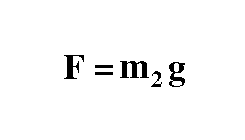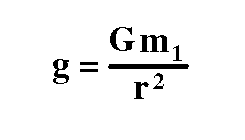Gravitational Acceleration
When making measurements of the earth's gravity, we usually don't measure the gravitational force, F. Rather, we measure the gravitational acceleration, g. The gravitational acceleration is the time rate of change of a body's speed under the influence of the gravitational force. That is, if you drop a rock off a cliff, it not only falls, but its speed increases as it falls.


In addition to defining the law of mutual attraction between masses, Newton also defined the relationship between a force and an acceleration. Newton's second law states that force is proportional to acceleration. The constant of proportionality is the mass of the object.
Combining Newton's second law with his law of mutual attraction, the gravitational acceleration on the mass m2 can be shown to be equal to the mass of attracting object, m1, over the squared distance between the center of the two masses, r.
Gravity
- Overviewpg 12
- -Temporal Based Variations-
- Instrument Driftpg 13
- Tidespg 14
- A Correction Strategy for Instrument Drift and Tidespg 15
- Tidal and Drift Corrections: A Field Procedurepg 16
- Tidal and Drift Corrections: Data Reductionpg 17
- -Spatial Based Variations-
- Latitude Dependent Changes in Gravitational Accelerationpg 18
- Correcting for Latitude Dependent Changespg 19
- Vari. in Gravitational Acceleration Due to Changes in Elevationpg 20
- Accounting for Elevation Vari.: The Free-Air Correctionpg 21
- Variations in Gravity Due to Excess Masspg 22
- Correcting for Excess Mass: The Bouguer Slab Correctionpg 23
- Vari. in Gravity Due to Nearby Topographypg 24
- Terrain Correctionspg 25
- Summary of Gravity Typespg 26